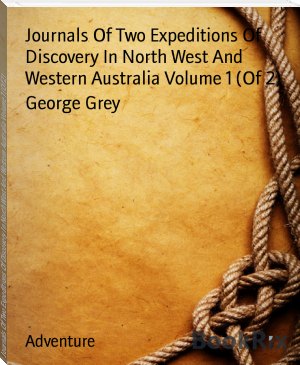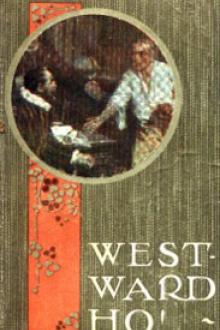Journals Of Two Expeditions Of Discovery In North West And Western Australia Volume 1 (Of 2) by George Grey (best ereader for pdf .txt) 📖

- Author: George Grey
Book online «Journals Of Two Expeditions Of Discovery In North West And Western Australia Volume 1 (Of 2) by George Grey (best ereader for pdf .txt) 📖». Author George Grey
Closely Resembling A Caterpillar.
Length From Head To Root Of Tail 0.7 Inches.
Length Of Tail (Or Rather Gelatinous Protuberance) 0.25 Inches.
Breadth (Broadest Part At Root Of Tail) 0.22 Inches.
Narrowest Part (Near Head) 0.15 Inches.
Length Of Head 0.12 Inches.
Head Of Light Red Colour, Mouth Apparent, Motion Of Head Like A
Caterpillar's When Touched, Shape Cylindrical, Body Gelatinous,
Intestines Apparent And Full.
November 16. Longitude 102 Degrees 40 Minutes East; Latitude 28 Degrees 5
To 6 Minutes South.
Since We Have Passed The 95th Parallel Of Longitude, And 32nd Of Latitude
Up To The Present Moment We Have Been Out Of The Region Of Birds, For
During The Whole Of This Period I Have Seen But Two, One Of Which, A
Petrel, Has This Moment Visited Us. We Have However Seen More
Volume 1 Chapter 3 (From The Cape Of Good Hope To Hanover Bay) Pg 36Sea-Jellies, Acalepha And Mollusca Than Before, And Those Of A Much More
Beautiful Kind. Thus Nature Has Made Up For The Deficiency Of One Tribe
Of Animals By The Profuseness With Which She Has Distributed Another.
November 18. Latitude 26 Degrees 57 Minutes South; Longitude 105 Degrees
22 Minutes East.
We Caught A Crustaceous Animal (Phyllosoma, See Illustration 11) Which
Was Perfectly Transparent; It Was Furnished With Twelve Legs On What I
Considered The Hinder Part Of Its Body, And Four Antennae In Front, Which
Have Their Tips Of A Bright Pink Colour, And Two Eye Peduncles By Their
Side, Which Terminate In Little Bags Containing Some Blue Matter (Their
Eyes). It Was Furnished Also With Two Legs Underneath. These Are Just
Shown In The Figure Near The Centre Of The Body, And Between Those
Underneath The Insect There Was A Slight Projection, With Two Little
Lumps On Each Side. In This Projecting Part There Appeared To Be An
Opening. When It Was Taken Out Of The Water It Stood Upright On Its Legs
And Crawled A Little Like A Large Beetle, But Soon Died. In The Water It
Swam With The Legs, And The Last Joint Appeared To Be Feathered. It Will
Be Seen That There Is A Great Irregularity In The Position Of The Legs Of
This Insect. The Specimen Appeared To Me To Be In Some Respects
Imperfect; But I Figured It Exactly As It Was, Without Blindly Guessing
At Its Perfect State. It Was Not Thicker Than The Thinnest Wafer. The
Back Was Marked With Curved Lines, Exactly In The Manner I Have
Represented. It Shrank Instantly When Touched. The Two Last Joints Of The
Long Legs Were Furnished With Thorn-Like Spikes.
Length Of Tail 0.37 Inches.
Of The Body 0.2 Inches.
Of The Thorax And Head 0.3 Inches.
Of The Entire Animal 1.4 Inches.
Breadth Of Body 0.62 Inches.
Ditto Of Thorax 0.51 Inches.
Length Of Third Leg 1.9 Inches.
Length Of Second Leg 1.7 Inches.
Length Of Hindermost Leg 0.6 Inches.
Length Of Eyes, Peduncles 0.4 Inches.
We Caught A Second Animal Of Exactly The Same Size As The One Figured,
But Apparently Much More Perfect. Each Of Its Tentacula Terminates In A
Small Feathering Tip When It Is In The Water, Like The Little Figures At
The Side, And By The Help Of Which They Swim; These Have A Horny Feel To
The Touch, Are Destitute Of Smell, And Look Like A Transparent Scale When
They Lie In Your Hand.
We Also Caught This Day Some Little Transparent Shells (Cuvieria) Of A
Cylindrical Form, And Blunt At The End; They Put Out Two Little Fins With
Which They Swam.
I Was Unfortunately Too Unwell This Day To Describe All The Other
Volume 1 Chapter 3 (From The Cape Of Good Hope To Hanover Bay) Pg 37Specimens We Caught, Which Were Numerous. The Sea Was Full Of Small
Acalepha, And In The Midst Of A Shoal Of These A Whale Was Seen.
November 19. Latitude 25 Degrees 50 Minutes South; Longitude 106 Degrees
22 Minutes East.
Birds First Re-Appeared Again. I Saw A Large Flock Of Two Kinds, But Was
Not Near Enough To Ascertain What They Were. I Have Before Noted The Fact
That Almost At The Exact Point Where The Southern Birds Of The Family
Longipennes Disappeared Those Sea-Jellies (Acalepha) Which Have The Power
Of Stinging, Began To Show Themselves; Previously To Our Passing This
Point I Had Not Seen One: I Saw Several However Today At No Great
Distance From This Flock Of Birds.
We Saw Float By This Afternoon One Of The Acalepha, Apparently About Two
Feet Long And Shaped Generally Like A Water Snake; Its Tail Had Fins Like
That Of An Eel, Of A Purplish Tinge; I Could Distinctly See Its Head And
Various Vessels In Its Interior For It Was Quite Transparent. We Had No
Net Ready But Threw A Stick With A Piece Of String Attached To It, The
String Passed Under It But In Pulling Up Cut Through It As Though It Had
Been Jelly.
Caught An Animal (Cymothoa) Shaped Exactly Like A Woodlouse:
Length 0.4 Inches.
Length Of Antennae 0.15 Inches.
Breadth Of Body 0.12 Inches.
It Had Six Legs, And A Tail-Like Fin Behind On Each Side, And Nine Rings
On Its Back So That It Could Roll Itself Almost Into A Ball, These Rings
Extended No Farther Than From Its Head To Within 0.12 Inches Of Its
Hinder Extremity; Colour Very Pale Blue Down The Back, Bright Prussian
Blue On Each Side; It Crawled About When Taken Out Of The Water, And
Lived For Some Time; Its Fins, Or Fin-Like Legs, When It Thus Crawled
About, Were Folded Under Its Tail; Eyes Distinct.
Mollusca.
November 20. Latitude 25 Degrees 14 Minutes South; Longitude 106 Degrees
49 Minutes East.
A Shell, Janthina Exigua, Was Caught This Evening, 8 Hours 30 Minutes
P.M.; When Brought Directly Out Of The Water Into A Room The Temperature
Of The Animal Was 80 Degrees 5'; Of Room 76 Degrees; Colour, Dark Violet
Purple Over Half The Opening And Lower Part Of The Shell, So That It
Gives The Animal The Appearance Of Having Been Upon A Purple-Coloured
Place; This Colour Then Dies Gradually Away, And In The Smallest Whorl Of
The Shell Becomes Almost White. They Had The Power Of Emitting Drops Of A
Violet Colour, And When Put Into Spirits A Great Quantity Of This Issued
From The Mouth Of The Shells. We Had One Evening Before Caught A Pair Of
Shells Of The Same Species, But Much Smaller, At Exactly The Same Hour;
In Both Instances Each Pair Were Caught At The Same Haul Of The Net.
Volume 1 Chapter 3 (From The Cape Of Good Hope To Hanover Bay) Pg 38
November 23. Latitude 21 Degrees 43 Minutes South; Longitude 109 Degrees
43 East. 8 1/2 P.M.
Flying Fish.
A Flying-Fish (Exocetus) Flew On Board. Its Temperature Was 74 Degrees.
The Colour Of Its Iris Was Black.
Length From Mouth To End Of Curve Between Forks Of Tail 10 Inches.
From Mouth To Commencement Of Wing-Like Fin 2.7 Inches.
Length Of Wing Fin 6.7 Inches.
Of Dorsal Fin 2.0 Inches.
Of Pectoral Fin 2.2 Inches.
Of Anal Fin 1.3 Inches.
Of Upper Fork Of Tail 2.2 Inches.
Of Lower Ditto 3.2 Inches.
Length From Mouth To End Of Gill 2.2 Inches.
Breadth Of Wing Fin 6 Inches.
13 Spines In Each Of These Wings.
Breadth Between Eyes 0.11 Inches.
Depth Of Fish 1.6 Inches.
Breadth Of Thickness 1.6 Inches.
Diameter Of The Eye 0.65 Inches.
Under-Jaw Projecting; Sides, Pale Green; Back, Blackish-Green; Belly,
White; Five First Spines In Wing Fin, Greenish; Others White; Wing-Fin
Dark Green With A Transparent Band Running Nearly Up The Centre From The
Back; Pectoral Fin, Transparent, With A Dark Green Spot, Nearly An Inch
Square, About The Centre Of Its Lowest Extremity; Tail, Dark Green, Edges
Light.
November 26. Latitude 16 Degrees 32 South; Longitude 117 Degrees East.
After Crossing About The 22nd Parallel Of South Latitude We Fairly
Entered Into The Region Of Flying Fish, And Dolphins As They Are Commonly
Called; Tropic Birds Were Now Also Frequently Seen, Which Had Not Up To
This Moment Been The Case; We Often Also Met Hereabouts With A
Dark-Coloured Bird With Bronzed Wings, Having A Cry Precisely Like A
Snipe. I Know Not The Name Of This Bird. The More Beautiful And Largest
Sea-Jellies (Acalepha) Had Now Disappeared, Although The More Minute Ones
Were As Numerous As Ever.
Remarks.
It Therefore Appears To Me That We Have, In Coming From The Southward To
This Point, Passed Through Three Great Regions, Or Zones, Of Animal Life,
One Extending From As Far To The Southward As I Have Yet Been, Namely 36
Degrees South Latitude To 31 Degrees South Latitude; This Zone Was
Volume 1 Chapter 3 (From The Cape Of Good Hope To Hanover Bay) Pg 39Inhabited By Numerous Sea-Jellies (Acalepha) Of The Smaller Kind, By
Porpoises And Whales, As Well As By Immense Varieties Of The Petrels Or
Procellariae.
The Second Zone Extending From 31 Degrees South To 22 Degrees South
Latitude Was Inhabited By Immense Numbers Of The Larger And More
Beautiful Kind Of Sea-Jellies (Acalepha) Particularly By Those That Have
The Power Of Stinging. Within This Zone I Saw But One Whale, One Shoal Of
Porpoises, And Not A Single One Of The Long-Winged Water Birds Or
Petrels; In Fact I But Once In The Whole Of This Distance Saw Any Birds;
There Were Also Here A Great Variety And Numbers Of Sea-Jellies
(Acalepha) Of The Smaller Kinds. Do Then The Larger Acalepha In This Zone
Perform The Office Of The Birds In The More Southern One, And Prey Upon
The Smaller Species Of Their Own Kind?
The Third Zone Is The One With Which I Have Commenced The Journal Of This
Day.
Water Snakes.
November 29. Latitude 15 Degrees 26 Minutes 32 Seconds South; Longitude
122 Degrees 3 Minutes East.
We
 Nowadays a big variety of genres are exist. In our electronic library you can choose any book that suits your mood, request and purpose. This website is full of free ebooks. Reading online is very popular and become mainstream. This website can provoke you to be smarter than anyone. You can read between work breaks, in public transport, in cafes over a cup of coffee and cheesecake.
Nowadays a big variety of genres are exist. In our electronic library you can choose any book that suits your mood, request and purpose. This website is full of free ebooks. Reading online is very popular and become mainstream. This website can provoke you to be smarter than anyone. You can read between work breaks, in public transport, in cafes over a cup of coffee and cheesecake.




Comments (0)